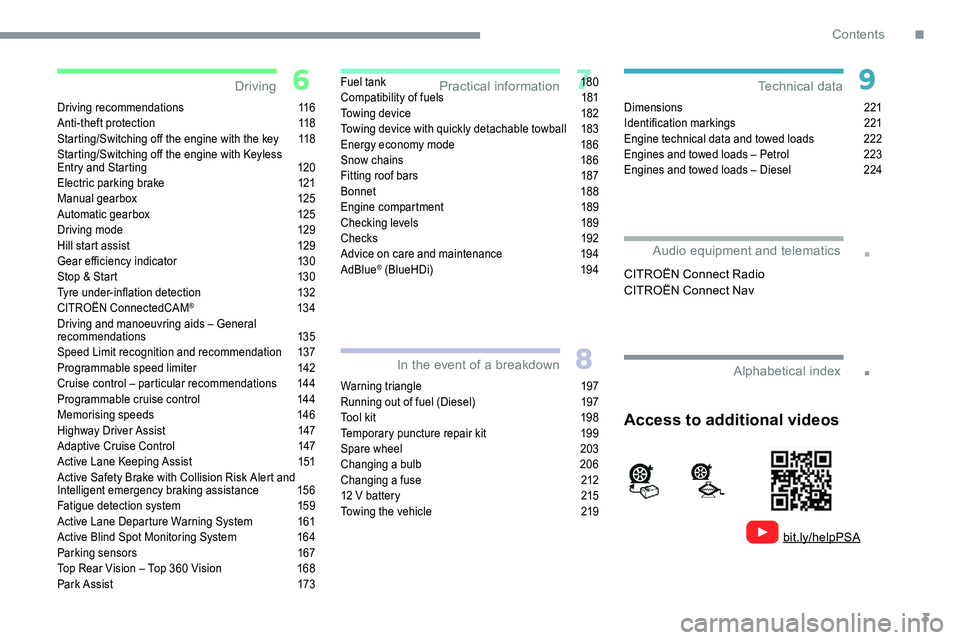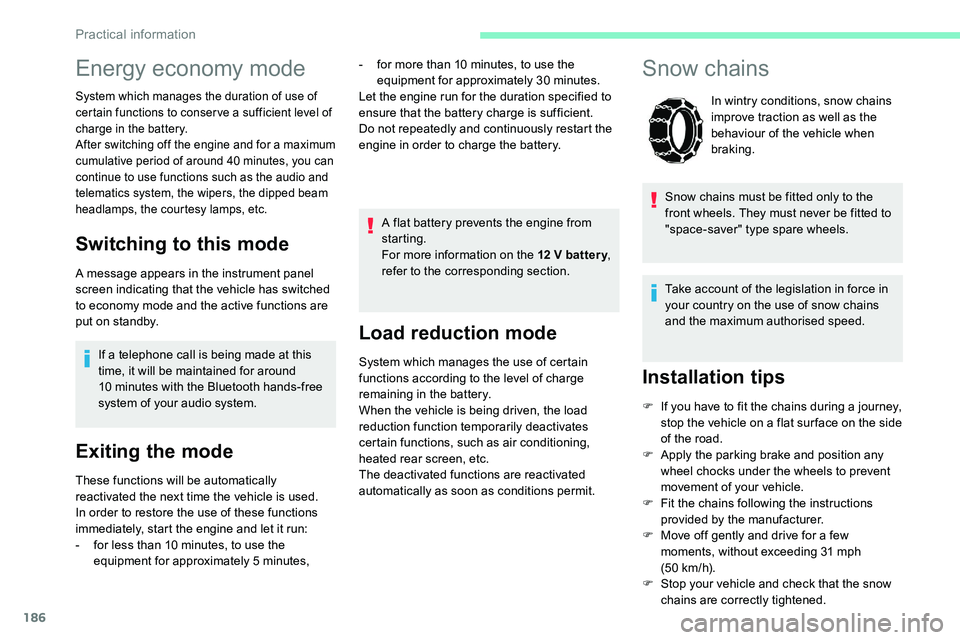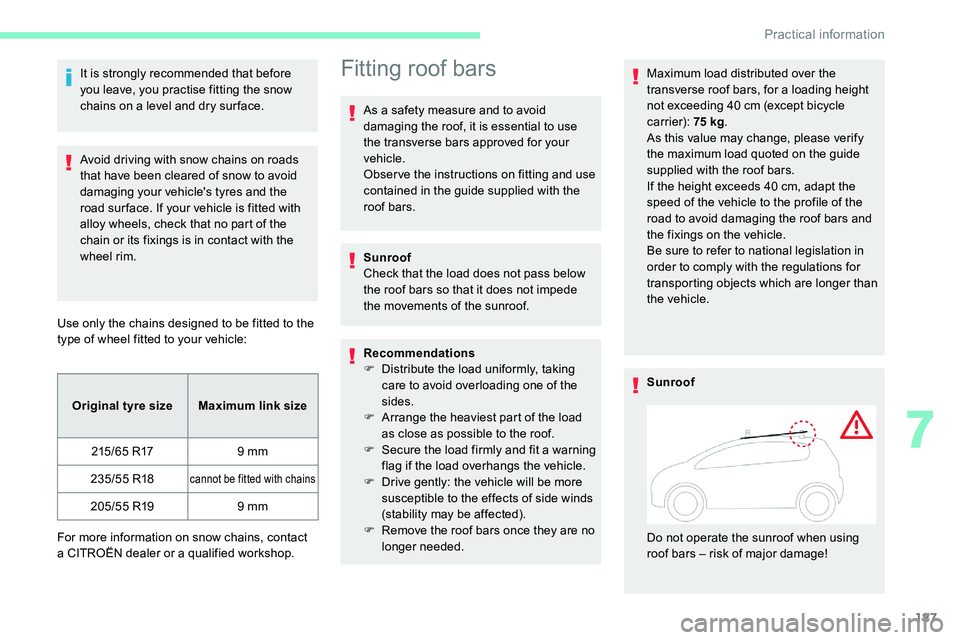snow chains CITROEN C5 AIRCROSS 2020 Handbook (in English)
[x] Cancel search | Manufacturer: CITROEN, Model Year: 2020, Model line: C5 AIRCROSS, Model: CITROEN C5 AIRCROSS 2020Pages: 292, PDF Size: 8.59 MB
Page 5 of 292

3
.
.
Driving recommendations 116
Anti-theft protection 1 18
Starting/Switching off the engine with the key
1
18
Starting/Switching off the engine with Keyless
Entry and Starting
1
20
Electric parking brake
1
21
Manual gearbox
1
25
Automatic gearbox
1
25
Driving mode
1
29
Hill start assist
1
29
Gear efficiency indicator
1
30
Stop & Start
1
30
Tyre under-inflation detection
1
32
CITROËN ConnectedCAM
® 13 4
Driving and manoeuvring aids – General
recommendations
135
Speed Limit recognition and recommendation
1
37
Programmable speed limiter
1
42
Cruise control – particular recommendations
1
44
Programmable cruise control
1
44
Memorising speeds
1
46
Highway Driver Assist
1
47
Adaptive Cruise Control
1
47
Active Lane Keeping Assist
1
51
Active Safety Brake with Collision Risk Alert and
Intelligent emergency braking assistance
1
56
Fatigue detection system
1
59
Active Lane Departure Warning System
1
61
Active Blind Spot Monitoring System
1
64
Parking sensors
1
67
Top Rear Vision – Top 360
Vision
1
68
Park Assist
1
73Fuel tank
1
80
Compatibility of fuels
1
81
Towing device
1
82
Towing device with quickly detachable towball
1
83
Energy economy mode
1
86
Snow chains
1
86
Fitting roof bars
1
87
Bonnet
188
Engine compartment
1
89
Checking levels
1
89
Checks
192
Advice on care and maintenance
1
94
AdBlue
® (BlueHDi) 1 94
Warning triangle
1
97
Running out of fuel (Diesel)
1
97
Tool kit
1
98
Temporary puncture repair kit
1
99
Spare wheel
20
3
Changing a
bulb
2
06
Changing a
fuse
2
12
12
V battery
2
15
Towing the vehicle
2
19Dimensions
221
Identification markings
2
21
Engine technical data and towed loads
2
22
Engines and towed loads – Petrol
2
23
Engines and towed loads – Diesel
2
24
Driving
Practical information
In the event of a breakdown Technical data
Alphabetical index
Access to additional videos
bit.ly/helpPSA
Audio equipment and telematics
CITROËN Connect Radio
CITROËN Connect Nav
.
Contents
Page 142 of 292

140
Activation/Deactivation
By default, the system is automatically
activated at every engine start.The function is activated and
deactivated in the Driving /Vehicle
menu of the touch screen.
Displays in the instrument panel
1. Detected speed limit indication.
or
2. Indication of the end of the speed limit.
The system is active but is not detecting speed
limit information. On detection of speed limit information, the
system displays the value.Operating limits
The legislation on speed limits is specific to
each country.
The system does not take account of reduced
speed limits in the following cases:
-
p
oor weather (rain, snow),
-
a
tmospheric pollution,
-
w
hen towing,
-
d
riving with a space-saver type spare wheel
or snow chains fitted,
-
p
uncture repair using the temporary repair
kit,
-
y
oung drivers, etc. The following situations may interfere with
the operation of the system or prevent it from
working:
-
p
oor visibility (inadequate street lighting,
falling snow, rain, fog),
-
w
indscreen area located in front of the
camera dirty, misted, frost-covered, snow-
covered, damaged or covered by a sticker,
-
f
ault with the camera,
-
o
bsolete or incorrect mapping,
-
o
bstructed road signs (by other vehicles,
vegetation, snow),
-
s
peed limit signs that do not conform to the
standard, are damaged or distorted.
Recommendation
For a suggested maximum speed, the first
t ime that the vehicle's speed exceeds it by
more than 3
mph (5 km/h) (example: 59 mph
(95
km/h)), the speed flashes for 10 seconds.
In addition to Speed Limit recognition and
recommendation , the driver can select the
speed displayed as a
speed setting for the
speed limiter or cruise control using the speed
limiter or cruise control storage button.
Driving
Page 146 of 292

144
Cruise control – particular
recommendations
For the safety of everyone, only use the
cruise control where the driving conditions
allow running at a constant speed and
keeping an adequate safety distance.
Remain vigilant when the cruise control
is activated. If you hold one of the speed
setting modification buttons, a very rapid
change in the speed of your vehicle may
o c c u r.
When descending a
steep hill, the cruise
control system cannot prevent the vehicle
from exceeding the set speed. Brake if
necessary to control the speed of your
vehicle.
On steep climbs or when towing, the set
speed may not be reached or maintained. Exceeding the programmed speed
setting
The speed setting can be exceeded
temporarily
by pressing the accelerator
pedal (the programmed speed flashes).
To return to the speed setting, release
the accelerator pedal (when this speed is
reached again, the display of the speed
stops flashing).
Operating limits
Never use the system in the following
situations:
-
i
n an urban area with the risk of
pedestrians crossing the road,
-
i
n heavy traffic (except versions with
the Stop & Go function),
-
o
n winding or steep roads,
-
o
n slippery or flooded roads,
-
i
n unfavourable climatic conditions,
-
d
riving on a speed circuit,
-
d
riving on a rolling road,
-
u
se of snow chains, non-slip covers or
studded tyres.
Programmable cruise
control
Refer to the General recommendations
on the use of driving and manoeuvring
aids and to Cruise control – par ticular
recommendations .
This system automatically keeps
the vehicle's speed at the cruise
value programmed by the driver
(speed setting), without using the
accelerator pedal.
The cruise control is switched on manually.
It requires a
minimum vehicle speed of 25 mph
(40
km/h).
With a
manual gearbox, it requires the
engagement of third gear or higher.
With an automatic gearbox, it requires the
engagement of mode D or of second gear or
higher in mode M .
The cruise control remains active after
changing gear regardless of the gearbox
type on engines fitted with Stop & Start.
Driving
Page 159 of 292

157
The system also takes motorcyclists and
animals into account; however, animals
below 0.5 m tall and objects on the road
are not necessarily detected.
This system is comprised of three functions:
-
C
ollision Risk Alert,
-
I
ntelligent emergency braking assistance,
-
A
ctive Safety Brake (automatic emergency
b r ak ing).
The vehicle has a
multifunctional camera
located at the top of the windscreen, and,
depending on version, a radar located in the
front bumper. As soon as the system detects a
potential
obstacle, it prepares the braking circuit in
case automatic braking is needed. This
may cause a
slight noise and a slight
sensation of deceleration.
Deactivation/Activation
By default, the system is automatically
activated at every engine start.
This system can be deactivated or
activated via the Driving /Vehicle
menu of the touch screen.
Deactivation of the system is
signalled by the illumination of this
indicator lamp, accompanied by the
display of a
message.
Operating conditions and
limits
The ESC system must not be faulty.
The DSC/ASR systems must not be
deactivated.
All passenger seat belts must be fastened.
Driving at a steady speed on roads with few
bends is required. In the following cases, deactivating the system
via the vehicle's configuration menu is advised:
-
t
owing a trailer,
-
c
arrying long objects on roof bars or roof
rack,
-
w
ith snow chains fitted,
-
b
efore using an automatic car wash, with
the engine running,
-
b
efore placing the vehicle on a rolling road
in a workshop,
-
t
owed vehicle, engine running,
-
d
amaged front bumper (version with radar),
-
f
ollowing an impact to the windscreen close
to the detection camera.
The system is automatically deactivated
after the use of certain "space-saver"
type spare wheels is detected (smaller
diameter).
The system is automatically deactivated
after detection of a fault with the brake
pedal switch or with at least two brake
lamps.
It is possible that warnings are not given,
are given too late or seem unjustified.
Consequently, always stay in control of
your vehicle and be prepared to react at
any time to avoid an accident.
6
Driving
Page 188 of 292

186
Load reduction mode
System which manages the use of certain
functions according to the level of charge
remaining in the battery.
When the vehicle is being driven, the load
reduction function temporarily deactivates
certain functions, such as air conditioning,
heated rear screen, etc.
The deactivated functions are reactivated
automatically as soon as conditions permit.
Snow chains
In wintry conditions, snow chains
improve traction as well as the
behaviour of the vehicle when
braking.
Snow chains must be fitted only to the
front wheels. They must never be fitted to
"space-saver" type spare wheels.
Take account of the legislation in force in
your country on the use of snow chains
and the maximum authorised speed.
Installation tips
F If you have to fit the chains during a journey,
stop the vehicle on a flat sur face on the side
of the road.
F
A
pply the parking brake and position any
wheel chocks under the wheels to prevent
movement of your vehicle.
F
F
it the chains following the instructions
provided by the manufacturer.
F
M
ove off gently and drive for a few
moments, without exceeding 31
mph
(50
km/h).
F
S
top your vehicle and check that the snow
chains are correctly tightened.
Energy economy mode
System which manages the duration of use of
certain functions to conser ve a sufficient level of
charge in the battery.
After switching off the engine and for a
maximum
cumulative period of around 40
minutes, you can
continue to use functions such as the audio and
telematics system, the wipers, the dipped beam
headlamps, the courtesy lamps, etc.
Switching to this mode
A message appears in the instrument panel
screen indicating that the vehicle has switched
to economy mode and the active functions are
put on standby.
If a
telephone call is being made at this
time, it will be maintained for around
10
minutes with the Bluetooth hands-free
system of your audio system.
Exiting the mode
These functions will be automatically
reactivated the next time the vehicle is used.
In order to restore the use of these functions
immediately, start the engine and let it run:
-
f
or less than 10 minutes, to use the
equipment for approximately 5
minutes,A flat battery prevents the engine from
starting.
For more information on the 12
V batter y
,
refer to the corresponding section.
-
f
or more than 10 minutes, to use the
equipment for approximately 30
minutes.
Let the engine run for the duration specified to
ensure that the battery charge is sufficient.
Do not repeatedly and continuously restart the
engine in order to charge the battery.
Practical information
Page 189 of 292

187
It is strongly recommended that before
you leave, you practise fitting the snow
chains on a level and dry sur face.
Avoid driving with snow chains on roads
that have been cleared of snow to avoid
damaging your vehicle's tyres and the
road sur face. If your vehicle is fitted with
alloy wheels, check that no part of the
chain or its fixings is in contact with the
wheel rim.
Use only the chains designed to be fitted to the
type of wheel fitted to your vehicle: Original tyre size Maximum link size
215/65
R17 9
mm
235/55
R18
cannot be fitted with chains
205/55 R19 9 mm
For more information on snow chains, contact
a
CITROËN dealer or a qualified workshop.
Fitting roof bars
As a safety measure and to avoid
d amaging the roof, it is essential to use
the transverse bars approved for your
vehicle.
Obser ve the instructions on fitting and use
contained in the guide supplied with the
roof bars.
Sunroof
Check that the load does not pass below
the roof bars so that it does not impede
the movements of the sunroof.
Recommendations
F
D
istribute the load uniformly, taking
care to avoid overloading one of the
sides.
F
A
rrange the heaviest part of the load
as close as possible to the roof.
F
S
ecure the load firmly and fit a warning
flag if the load overhangs the vehicle.
F
D
rive gently: the vehicle will be more
susceptible to the effects of side winds
(stability may be affected).
F
R
emove the roof bars once they are no
longer needed. Maximum load distributed over the
transverse roof bars, for a
loading height
not exceeding 40 cm (except bicycle
carrier): 75 kg.
As this value may change, please verify
the maximum load quoted on the guide
supplied with the roof bars.
If the height exceeds 40
cm, adapt the
speed of the vehicle to the profile of the
road to avoid damaging the roof bars and
the fixings on the vehicle.
Be sure to refer to national legislation in
order to comply with the regulations for
transporting objects which are longer than
the vehicle.
Sunroof
Do not operate the sunroof when using
roof bars – risk of major damage!
7
Practical information
Page 286 of 292

228
RS
T
Radar (warnings) ........................................... 13 6
Radio ........................................ 5 - 6, 8, 20 -21, 23
Radio, digital (Digital Audio Broadcasting – DAB)
................................7, 2 2
Range, AdBlue
........................................ 28, 192
RDS
................
............................................. 6, 21
Rear screen, demisting
.............................68-69
Recharging the battery
.................................217
Recirculation, air
....................................... 65 - 67
Recovery
....................................................... 219
Reduction of electrical load
..........................18 6
Regeneration of the particle filter
.................192
Reinitialisation of the under-inflation detection system
.................................. 13 3 -13 4
Reinitialising the remote control
..................... 43
R
eminder, key in ignition
...............................11
9
Reminder, lighting on
...................................... 80
R
emote control
............................... 35-37, 39-41
Removing a
wheel ................................ 203-206
Removing the mat
........................................... 74
Replacing bulbs
..................... 2
06 -207, 210 -211
Replacing fuses
..................................... 212-213
Replacing the air filter
................................... 19
2
Replacing the oil filter
................................... 19
2
Replacing the passenger compartment filter ...192
Reservoir, screenwash
................................. 191
Resetting the service indicator
................. 26-27
Resetting the trip recorder
.............................. 30
Reset trip
......................................................... 31
Rev counter
................................................... 8-9
Reversing camera
.................. 1
3 6 , 16 8 -16 9, 171
Reversing lamps
..............................
............. 210
Roof bars
................................................ 187-188
Running out of fuel (Diesel)
................... 197-198 Safety, children
........
101-102, 104 -107, 110 -114
Saturation of the particle filter (Diesel) .........
192
Screen menu map
...........................................
11
Screenwash, front
...........................................
86
Screenwash, rear
............................................
86
Selective Catalytic Reduction (SCR)
......
29, 19 4
Seat belts
..................................
13, 98 -10 0, 109
Seats, electric
...........................................
56-57
Seats, front
...............................
.................
54-57
Seats, heated
..................................................
57
Seats, rear
.................................................
60 - 61
Selector, gear
.........................................
125 -12 9
Sensors (warnings)
.......................................
137
Serial number, vehicle
..................................
221
Service indicator
..................................
2 6 - 2 7, 2 9
Service (warning lamp)
...................................
14
Servicing
................................ 1
4, 26, 26 -27, 192
Settings, equipment
........................................
33
Settings, system
........................................
15, 29
Sidelamps
................................. 7
9, 81, 209 -210
Side repeater
................................................
209
Snow chains
..................................................
18 6
Socket, 12 V accessory ............................
72, 76
Socket, auxiliary .......................................... 8, 23
Socket, Jack ....................................................
23
Socket,, USB ......................................... 72, 8, 22
Speed limiter
.................................. 14
0 -143, 14 6
Speed limit recognition
......................... 1
3 7, 1 4 0
Speedometer
........................................ 8 - 9, 137
Spotlamps, side
............................................ 20
9
Stability control (ESC).................... 91-92, 94-96
Starting a
Diesel engine
............................... 18
1
Starting the engine
....................................... 11
8
Starting the vehicle
...18, 21-2 2, 118 -120, 125 -129Starting using another battery ..............121, 216
Station, radio ............................... .......5 - 6, 20 -21
Stay, bonnet
........................................... 188 -189
Steering mounted controls, audio
............ 2-
3, 2
Steering wheel, adjustment
............................ 58
S
topping the vehicle
...........................18, 21-22,
118 -120, 125 -12 9 STOP (warning lamp)
......................................
12
Stop & Start
.................................
23, 32, 63, 68,
130, 132, 180, 188, 192, 218
Storage
...........................................
71, 73 -74, 76
Storage box
.....................................................
78
Storage compartments
...................................
71
Storage wells
............................................
76, 78
Storing driving positions
........................... 5
6-57
Stowing rings
..................................................
76
Sunroof, panoramic
.................................. 5
2-53
Sunshine sensor
.............................................
62
Sun visor
...............................
..........................
71
Switching off the engine
...............................
11 8
Synchronising the remote control ...................
43
Tables of engines
..................................
223-224
Tables of fuses ...............................
212-213, 215
Ta n k , f u e l
.......................................................
18 0
Technical data
....................................... 22
3-224
Telephone
........................... 7
2-73, 12-14, 24-27
Temperature, coolant
................................
12, 27
Third brake lamp
...........................................
2 11
Three flashes (direction indicators)
................ 80
T
icket holder
...................................................
71
Time (setting)
......................................
34, 15, 30
TMC (Traffic info)
............................................
14
T
ool kit
.............................................
78, 198 -19 9
Top 360 Vision ......................................
16 8 , 171
Topping up AdBlue
® ...................................... 19 6
Top Rear Vision..................................... 168 -169
Total distance recorder
................................... 30
Touch screen ................................................. 1, 1
To w b a r
...............................
...................... 9 4, 182
Towbar with quickly detachable towball ...183 -185
Towed loads
.................................................. 222
Towing another vehicle
................................. 219
Traffic information (TMC)
................................ 14
Tr a i l e r
...............
....................................... 9 4, 182
Alphabetical index